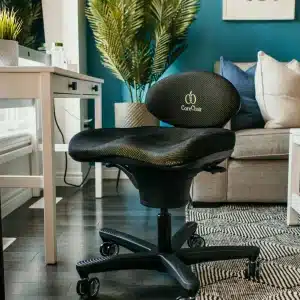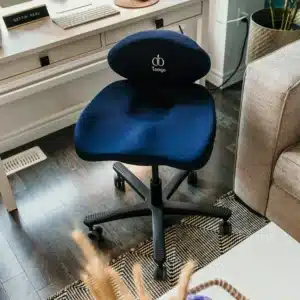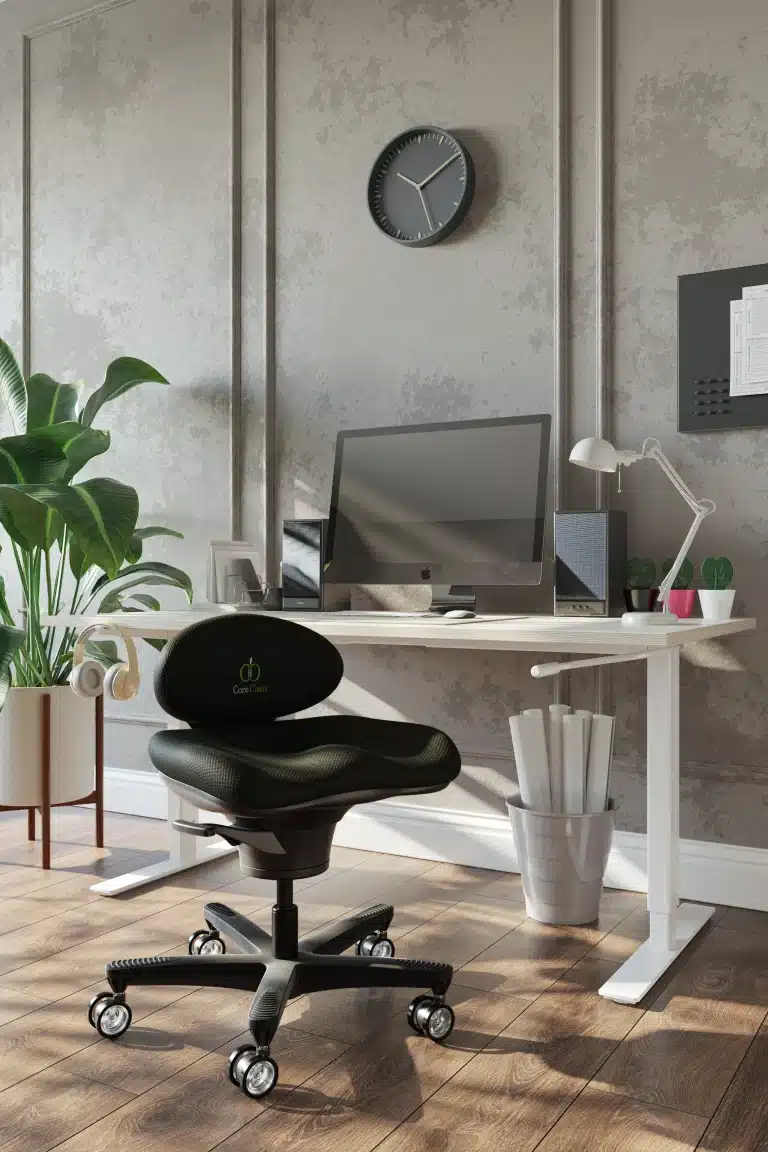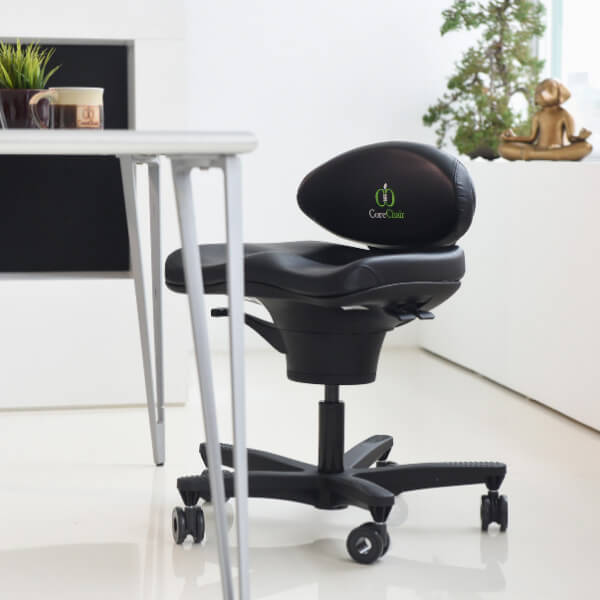It looks like computers are here to stay and the evidence suggests that the deleterious effects of sitting and not moving are similar to standing and not moving.
So let’s agree that a mix of sitting and standing is ideal and spend some time identifying the ideal computer chair ergonomics.
What is ergonomics?
Ergonomics simply put is the pursuit of optimal human interaction with their workspace, considering biomechanics and physiology with the primary objective to prevent injury and negative health consequences.
What are computer chair ergonomics?
Assuming that the primary workspace is a desktop computer, computer chair ergonomics is the review of the biomechanical challenges and how the appropriate computer chair can diminish the potential negative consequences.
What are the biomechanical challenges of working at a computer?
When we assume a sitting position in front of a computer, especially for a prolonged period of time, there are a number of key variables that can compromise our biomechanical efficiency when seated and lead to poor posture, pain and injury. The following are some of the very fundamental considerations;
1. Chair selection for fit that has adjustment to accommodate your size, physique and body mass.
2. How one should be positioned in their computer chair
3. Does the chair allow and encourage movement to avoid static sitting and the sedentary outcomes.
4. Desk or work surface height
5. Computer monitor position
1. Computer Chair Selection for ergonomics
It is obvious that there is no one chair that will adequately accommodate everyone. The majority of computer chair designers focus on a high percentage of the potential population of users and integrate adjustments to fine tune the fit.
In the current world of computer chair ergonomics there are an immense number of manufacturers of computer chairs and the clear majority present a solution that varies only slightly from each other when considering ergonomics or the approach to support and body positioning. Most are differentiated by the quality of materials, cosmetic finish or the amount of adjustment possibilities. Other than this they most computer chairs are very similar in general appearance.
In fact sometimes the high end ergonomic computer chairs, with an impressive assortment of adjustments, fail in practice, as many of the users over time make changes and struggle to recall what the “best” position should be and how to adjust their chair to achieve this.
Many large organizations provide a computer chair along with a desk as the basics to one’s employment. The purchase decision is focused on consistent design for ease of maintenance and appearance in a large office space, but also the cost to purchase in bulk.
2. What is the ideal sitting position
Traditional approach
For the longest time traditional ergonomics and the profession of ergonomists have promoted that a person should sit with a 90-90-90 position.
This means that their computer chair ergonomics should have them sitting upright with their hips bent to 90 degrees of flexion, their knees should be at 90 degrees of flexion and their ankles should be at 90 degrees of flexion.
Then when it became evident that the greatest nemesis to optimal sitting posture was gravity, this general recommendation shifted to provide for a slight recline of the back which would open the hip angle and allow more of the gravitational force on the upper body to be spread over more of the spine.
Of course some problems arise from this in that the head and neck are required to move or flex forward to optimize optical fields and the reclined position encourages the sit bones to slide forward on the sit surface which compounds the posterior tilt of the pelvis and overall flexion of the spine and the physiological challenges that arise from this.
The fix is to add more support like neck and head rests, arm supports and more which obviously leads to static positioning.
Good ergonomics for computer chairs must address healthy movement to avoid sliding into the perils of sitting or sitting disease.
Engaged sitting approach
Respecting nature and the effects of gravity in particular, many people intuitively sit on the front edge of their ergonomic computer chair and assume an engaged sitting position where their knees are lower than their hips, pelvis is more upright, back is extended, core stabilizing muscles engaged and ears are over the shoulder. Balanced.
When the users spine is positioned in natural extension or similar to that of standing, the vertebrae align as originally intended and the forces that gravity applies is shared evenly over the complimentary structure and these vertebrae and allow the supportive soft tissues to work less by only providing balance and stability for these structures.
When these vertebrae are in a position of natural extension their ability to perform all intended functions is optimized. Flexion, extension and rotation.
This position for computer chair ergonomics is often referred to as perching. While it is a good position and one that the individuals feel makes them more effective, it is not sustainable as they have to engage their core stabilizing muscles too much and for too long. Fatigue sets in and eventually they collapse and the ideal functional position becomes dangerously uncomfortable.
The design approach that CoreChair introduces to computer chair ergonomics is that it follows this intuitive approach to ergonomic positioning by providing a sculpted seat that works in harmony with a strategically designed low back that together embrace the pelvis to hold it in a neutral upright position, encouraging the ascending spine to assume a balanced, extended orientation, allowing the supportive soft tissues to work less and allow more freedom of movement.
This postural position in terms of computer chair ergonomics, is ideal to support the head in a balanced position as the user confronts the computer monitor.
This position is very similar to the intuitive position of perching as described above but the CoreChair supports the pelvis and seriously diminishes the fatigue factor.
So, two different options for sitting positions. To determine the best option for you, it is important to understand the mechanics and listen to your body. Body awareness is the key to finding the best solution.
3. The value of movement while you sit in a computer chair
Many people strive to understand and find the “best” computer chair ergonomics and overlook the fact that if you maintain only one position for prolonged periods of time, your metabolism will grind towards inactivity and you will be technically sedentary.
When your metabolism reduces so significantly, many vital organs in your body become challenged. Research suggests that the overall sedentariness that we endure as a result of sitting in a computer chair for 8 hours or more a day, combined with sitting sedentary through our commute, and lounging when we return home, not only leaves us feeling lethargic but puts us at risk of developing serious illness that include but are not limited to diabetes, cardiovascular disfunction and even some forms of cancer.
The solution is simple, we need to move. We were designed to move and our techno evolution has caused us to become sedentary.
An hour a day in the gym is very helpful but the ability to create an environment such as a computer chair that moves at low intensity but with a high duration, is ideal as we attempt to optimize the function of our vital organs and strengthen our core.
A study conducted by the Mayo Clinic and Arizona State University found that subjects using a CoreChair passively compared to a traditional ergonomic computer chair, increased the caloric burn (metabolic indicator) by 20%.
A study conducted by Guelph University determined that sitting on a CoreChair compared to a traditional stationary chair increased cognitive function, identified as a reduction of errors over a 4 hour study.
A study by memorial University found that venous return from the lower extremities, measured as the girth or fluid accumulation in the lower calf, was significantly less when subjects sat in a CoreChair compared to a fixed traditional computer chair.
While there may be great enjoyment to lounge on your couch for some time after a long day at work, while you are at work, it is important that you incorporate movement as much as possible. Not just for a minute every hour but as frequently as possible.
4. How high should a desk or work surface be to compliment a computer chair
Traditional ergonomics has dictated a standard height desk for quite some time at 29 to 30” floor to top surface. While this may be the proper height for someone who is 5’8” to 6’2”, it is definitely not proper height for someone 5’2”.
When the work surface is too high, the shorter user is forced to bend at the elbows excessively to allow them to place the heels of their hands on the top surface. With the elbows bent to less than 90 degrees, the shoulders have a tendency to elevate, which in turn engages the upper back and neck muscles. Fatigue and pain over time.
Thank fully the introduction of sit to stand desks has allowed the opportunity to set the desk height for every individual.
Ideally the person using a computer chair for good ergonomics should be comfortably positioned with their feet flat on the floor and with the heels of their hands on the top of the work surface their elbows should be bent to 90 degrees or slightly more.
CoreChair focuses on easily maintaining an upright pelvis and a balanced and engaged spine. The adjustment of the chair by raising it up, while the seat fluidly tilts down to the front, allows the user to assume a more open hip angle and in turn more extension in their spine.
When making this adjustment to your computer chair, it is important to observe how it affects the orientation to the work surface, using your elbow angle as a guide.
5. How high should my monitor be for good computer chair ergonomics
Now that you are positioned in a good posture with healthy movement and orientated to an appropriate desk height, it is important to know that the next important variable is the position or height of your computer monitor.
Very simply, you should be able to comfortably look straight across to the top of your monitor. To put that in perspective, when you are looking down at your cell phone, most often your head is dramatically tilted forward and down. This necessitates the over engagement of your posterior neck muscles to hold your quite heavy head in place.
Two things happen as a result.
• This orientation of your head pulls your cervical spine into forward flexion which then pulls your thoracic spine into flexion. Often we think of how the posterior tilted pelvis initiates spinal flexion from the base but the head and neck/ cervical spine initiates similar from above.
• Obviously the strain on the posterior neck muscles results in fatigue and discomfort.
Ideally we should be positioned in our computer chair for good ergonomics, with our pelvis vertical, our spine in an upright balanced position with our arms hanging relaxed at our sides, heels of our hands on the desk top with elbows at 90 degrees and ears comfortably balanced over our shoulders.
What is the best computer chair ergonomics?
There are two options for best ergonomics for computer chairs.
The traditional ergonomic path is to sit slightly reclined, with additional support, slightly open hip angle, knees at 90 degrees and ankles at 90 degrees.
The more engaged solution is assuming an upright pelvic position with an open hip angle, where knee angle an ankle angle follow the path that allows your feet to be flat on the floor.
Either solution need to allow for more movement which generally means less support except through the pelvis which represents the foundation of our human structure.
How do you evaluate the best computer chair for you?
With thousands of computer chair manufacturers it is not an easy task to determine which solution is best for you.
If you have tried the traditional approach and have not been satisfied then either identifying a traditional design that is significantly different than your experiences or investigate an engaged position computer chair.
Furniture stores generally have a variety of different models that will allow you an opportunity to sit on all. This is usually not very effective as so much has to be determined in such a very short period of time and in the absence of your work space.
It is usually beneficial to conduct your research for general knowledge of computer chair ergonomics as well as the commercial options and determine if you can purchase with a satisfaction guarantee.
Your research should broaden your understanding of body awareness and what you might expect from any solution but having this computer chair set up in your workspace is a much more effective method to select the proper solution.
CoreChair has been validated by many University studies to be effective for postural positioning and enhanced outcomes from the active sitting feature. The company offers their computer chair in several models and provide a satisfaction guarantee and customer support in the form of extensive educational videos and personal one on one technical support.
Of course a good manufacturer’s warranty and commitment to your comfort and productivity is always a good way to identify the value add. CoreChair offers an 8 year warranty a wide variety of informational videos and live customer service to optimize the effectiveness of your CoreChair computer chair for excellent ergonomics.










